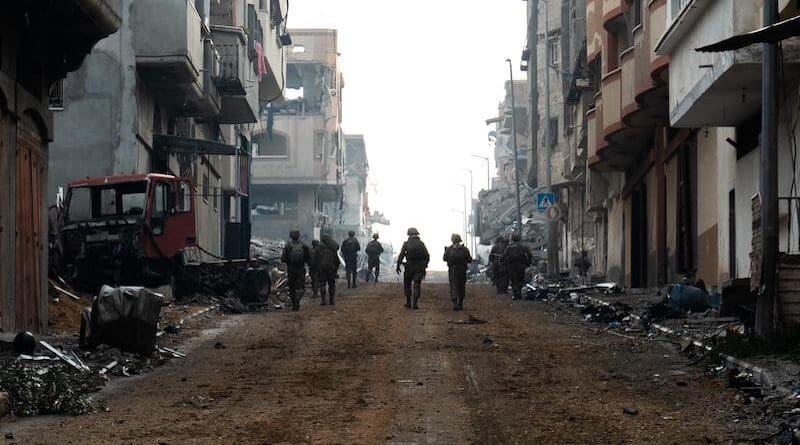Israel’s Dilemma: Three Unappealing Choices In The Gaza War – OpEd
The recent escalation of violence between Israel and Hamas has left Gaza in ruins and raised questions about Israel’s intentions. Israel’s immediate goals are clear: to free its captives, to deter future attacks from Hamas, and to avoid a wider war with Iran and Hezbollah.
To achieve these goals, Israel has three military options: to reoccupy Gaza, to destroy Hamas and leave Gaza, or to find a new ruler for Gaza after eliminating Hamas. However, none of these options are easy or desirable, as they all entail high costs and risks for Israel and the region.
Reoccupation of Gaza
This option involves Israel taking back control of the Gaza Strip, which it left in 2005, and governing the Palestinian territory. Some hardliners in Israel’s government, military, and intellectual circles support this option. They believe that re-establishing military control over Gaza can eliminate the future threats that it poses to Israel’s security. They call for a full-scale ground invasion and a sweeping operation to wipe out Gaza’s armed groups. This option is a long and bloody war. Israel will face fierce resistance in Gaza, which could kill hundreds of Israeli soldiers. Israel will also have to provide basic services for many Gazans, which will strain its economy. Moreover, this option will damage Israel’s international reputation, as it will cause many civilian deaths and casualties.
Destruction of Hamas and withdrawal from Gaza
This option involves Israel eliminating Hamas and leaving Gaza without taking responsibility for its governance. This could result in Gaza descending into chaos and violence, as different factions vie for power in the absence of Hamas. This scenario could resemble the situation in Iraq after the US toppled the Baath regime in 2003. Some of the groups that could fill the gap left by Hamas – such as Islamic Jihad – may pose an even greater threat to Israel than the current rulers of Gaza. Despite its violent attacks on Israel in a recent surprise assault, Hamas has shown some willingness to compromise with Israel by endorsing a two-state solution along the 1967 borders in its 2017 charter. However, if Hamas loses its grip on power, Gaza could become a haven for extremist militias from North Africa, Syria, and Iraq. This would create a nightmare scenario for Israel, akin to having a mini-Mogadishu on its doorstep.
Destroying Hamas and replacing it
If Israel wants to get rid of Hamas and take over Gaza, it will need to find a new partner to share the governance of the territory. Israel will try to cultivate other local factions and movements in Gaza that can cooperate with it in forming a new ruling party. These could include tribal leaders, civil society groups, municipal officials, or even prominent figures from Fatah, the political party that runs the Palestinian Authority. Israel will likely involve the Palestinian Authority in this process, as it would be the most suitable or logical choice for Tel Aviv. The Palestinian Authority has the experience of managing Gaza before the 2006 elections, when it lost power to Hamas after a violent conflict.
However, the main challenge here is that Fatah and the Palestinian Authority have lost much of their popularity among Palestinians in recent years. In the West Bank, where they are in charge, Palestinians increasingly view them as collaborators of Israel’s military occupation. They are seen by many Palestinians as a corrupt and ineffective elite, with no political vision, and this creates a space for alternative narratives and methods of resistance against the occupation, represented by more radical groups such as Hamas or Islamic Jihad.
None of these three scenarios can be realized unless the Israeli army can completely wipe out Hamas, which is highly doubtful. The extensive network of underground tunnels and the urban warfare in a densely populated strip would pose enormous military challenges for any conventional army. Furthermore, even if Israel destroys much of Hamas’s infrastructure, its ideology will persist. Hamas is now more popular than ever. Its public support in both Gaza and the West Bank has soared after the Israeli airstrikes.
It is unclear what Israel’s goals are for Gaza without Hamas, or which military strategy will best serve them. Even Israeli leaders seem to be confused about this. Re-occupying Gaza may appeal to some Israelis who want to reclaim the entire Holy Land, but it would be a costly and risky option. It would entail a heavy financial burden, possible high casualties, and increasing international pressure. Starting a war that crushes Hamas and then abandons Gaza would be the worst possible outcome. It would create a power vacuum that other forces would fill. The Middle East has seen many examples of radical groups exploiting ungoverned or weakly governed areas. The most desirable solution may be to restore the Palestinian Authority’s control over Gaza, in cooperation with Israel, as in the West Bank. But this path is fraught with obstacles, as well.
Fatah cannot hope to return to the now rubble of Gaza with the presence of Israeli tanks. The Palestinian Authority is widely seen by Palestinians as a corrupt and outdated organization, dominated by decadent leaders. This perception is even stronger in Gaza, where Hamas rules. Fatah’s 60,000 security forces are barely able to secure a third of the West Bank under their control. It is not hard to imagine that they would stand no chance in Gaza. Fatah’s comeback to Gaza would surely face fierce resistance. These options show that Israel is stuck with very bad choices. The road for Israel to achieve its desired outcome through military action and invasion of Gaza is full of obstacles at best and practically impossible at worst.

